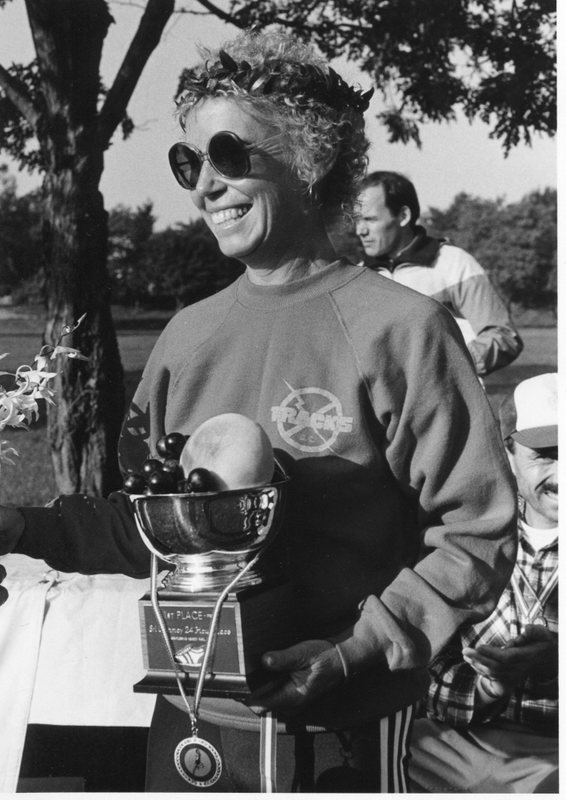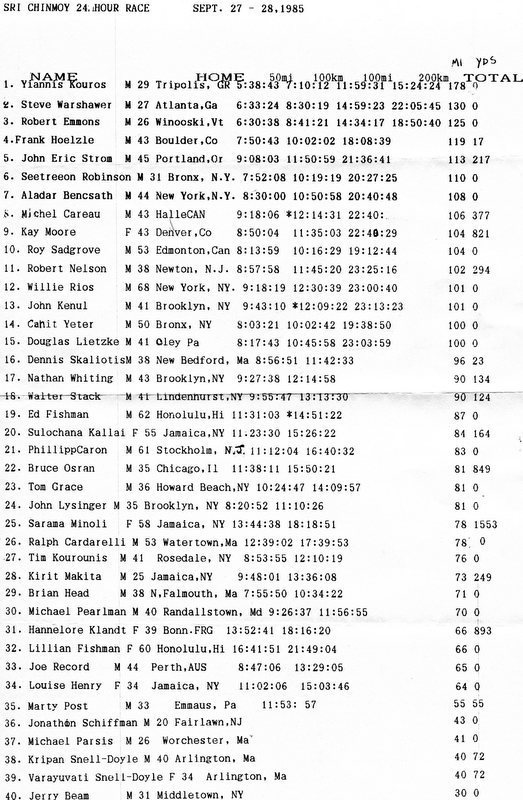1985: The 24-hour Fights Weather, City Officials, and Self-Doubt; Golden Greek Conquers All
The registered number of entrants had swelled to 76 runners as the date of the seventh running of the Sri Chinmoy 24-Hour Race approached- September 27-28, 1985. The Marathon Team had been kept busy all spring and summer with the Sri Chinmoy 70 Mile Race, but that race started and finished in one day inside of our first-ever multiday affair- the Sri Chinmoy 1000 Mile Race, held May 1-17, 1985. Three men actually finished the distance of 1000 miles on the one-mile loop on the same course the 24-Hour would travel upon. (editor: To this date the SCMT, under the guidance and inspiration of Sri Chinmoy for the last 40 years, has been able to sponsor 124 multi-days in 31 years, something that no one ever thought was possible, or would ever happen. A multiday is any race beyond 24 hours.)
One of our main directors was in England running the London to Brighton race, a decades long fixture on the ultra scene. A week before our 24-hour, he called and assured me he would be back two days before race day to help with the set-up, registration and assume his position of main RD. We had a good set-up crew ready to begin construction of a counting tent, aid station and medical tent, since a race of this size was more than we had ever hosted. Two days before the start, I watched in consternation at a store on TV -that a hurricane was headed for the eastern seaboard, scheduled to arrive in New York on Friday, September 27th, race-day in Flushing Meadows.
Complications arrived in minutes as I ran home. The main RD called - his flight was cancelled. The City of New York was contemplating whether to shut everything down- subways, buses, bridges, tunnels for two whole days. Our small group of workers proceeded to the course to put up the tents, and the weather was calm and clear at that moment. Things were tied down extra firm, but we had no provisions for winds over 50 miles an hour. Runners were frantically calling to see if the run was still on. Calls were made to ask Sri Chinmoy for advice- would the race still be on. I noted numerous cancellations from concerned runners in the five-state area.
I could not blame the runners for cancelling while a F-2 hurricane (90-112 mph winds) headed for NYC. At 11:00 pm I went back to the race site to guard the constructed tents and survey the situation. Listening to the devastation and tidal surges in Virginia Beach and due south of Washington, DC, on the radio, it was clear that there was a call to be made, both by the City officials, the Parks Commissioner, and Sri Chinmoy himself. My feeling was, either way, if we had the race it might not be the best race, but it would definitely be interesting. And if it was cancelled, we would refund money to the athletes and try again later. I stayed overnight to monitor the situation and see if it got any worse. The heavier winds at night nearly flattened anything in sight, including our tents as the storm intensified.
I knew Sri Chinmoy would make the right call. We called Park officials and they were adamant that the City was closing everything down, due to threats of high winds and tidal surges. Some of our men went to the City officials with Guru’s decision. We would have the race. Guru would take full responsibility for the event, and that the City, the Parks, and no public official would be responsible for anything. Guru told them that the runners would be safe, the storm will not harm them.
There was even a TV newsman that said that the City was closed down, all the parks were closed, all the events were cancelled for the weekend; ‘except for this long race in Flushing Meadows. Guru Sri Chinmoy said, “God will protect the runners. “ ‘I sure hope so.’
An hour before the start the runners who had chosen to brave the storm and run, arrived. The winds had picked up to 30-40 mph gusts, knocking over our tents for counting, and flattening anything not tied down. We made decisions to have counters sit in dry cars near the start/finish area to count the laps. Tables were tied down with heavy construction blocks to be used for aid stations. The medical tent was moved to a large rented panel truck, with room for two massage tables or beds and supplies. Food and aid for runners and helpers was given out of a van. Runners coming with their cars kept their vehicles parked close to the track, but away from trees. The runners gathered to the starting line, dressed in raincoats, consternation on some faces, but ready to accept the challenge. We made sure that anyone who felt threatened or in danger would get help or be brought home if necessary. A moment of silence ensued just before the start. The rain became steady, the runners move forward as the horn sounded at 8:06:34am.
The conditions presented a challenge, but any ultra-runner who has ever spent a full day running knows the distance covered in the journey is just as tough as any conditions that accompany it. Yiannis Kouros moved ahead of Steve Warshaher, 27, from Atlanta, GA, -a fine 100-mile runner, with a 6:22 first mile, followed by a 6:15, 6:18, 6:13. Then, Yiannis did 10 miles- 63:11; 20 miles- 2:07:43, 50 km- 3:20:35. Robert Emmons from Winooski, VT came up to the shoulder of Warshawer and ran with him for several miles. The wind picked up, reaching 50 mph to 60 mph, but due to trimming of the trees in the park on a regular basis, no large branches ever fell onto the course throughout the entire race. It almost seemed like the winds stayed above the tops of the trees. The supposed hurricane had become a much weaker tropical storm.
When Yiannis Kouros hit 50 miles in 5:38:43, he was about 11 minutes behind his pace from 1984. Most of the rain was swirling about, but the temperature was warm, in the 70º range for much of the first 10 to 12 hours. Kay Moore led the six women running the race. She was looking good and having no problems, other than being slowed like nearly everyone else.
Sri Chinmoy was calling us constantly for a few hours, and when the situation of wind and rain did not worsen, we knew things might be okay. Prognosticators had said the worse winds and tides would start at 12:00 pm, but we seemed to have escaped them by then.
Yiannis Kouros went past the 100 km split about 15 minutes behind his time from last year. It seemed like any record was out of the question. Steve Warshawer was 1 hour, 20 minutes behind at that point, holding second place. Robert Emmons was just about a lap behind in third. The rest of the field was just hanging on as the field was buffeted by the wind, but its strength was somehow manageable. At one point the rain stopped, and the sun peeked out of the clouds for a moment. Maybe it was the eye of the storm taking a look as it left the area. Giant clouds in the higher atmosphere were going by at incredible velocity. Soon darkness descended.
The only problem now was the streetlights along the park roads. I don’t think that the parks people intentionally shut off the switches and circuits, but no rows of lights were on in any portion of the race course. So we arranged for several cars to use their headlights to mark the way. At the far turn one could glance at the other parts of the big, public park and see bright lamps shine through the damp haze everywhere. We had paid for use of the Park, always ahead of time, as well as the permit for the race, and cleaned the entire mile loop if necessary. We never saw a police car come by, or even a Parks Ranger. Yet, we were still grateful to be at the race, in the moment.
By the time he hit 100 miles, Yiannis Kouros was still 13 minutes behind the record pace at 11:59:31.Yiannis was still running 8:10 to 8:25 miles regularly, with just under half the race to go. He held his pace through 200km(15:24:24) and continued on to a realm only he could navigate in the dreary, dark night. Ticking off each mile from 8:20 to 8:35 pace seemed effortless. With the first specks of light from the hidden but rising horizon, the Greek runner had twenty miles to cover in just over three hours to tie his all-time best.
The energy level of the race was now growing a little as the last few hours remained. Shuffles turned into stride outs, limpers turned into joggers, runners discovered a new purpose. The wind-swept park roads revealed the runners had survived the night. Only three or four went inside their cars to go home in the early hours. The rest stayed. Yiannis had triumphed by holding his pace. In the last hour he slowed, knowing that the effort in the shadows of night, among the thousands of twigs shed from trees, had brought him to the finish line, finally, with 178 miles completed. Ultimately, another record had been transcended by the great runner.
Kay Moore led the women again with a solid 104+ miles, eager to find a hot bath. The Queens masters record holder Willie Rios, at age 68, broke his own record by 11 miles, cresting 101 miles. In all, 14 runners made it past 100 miles in 24 hours. We had seen everything in the previous two days. It made it sweeter that the race had been run, that records were set in such hardship, and that extraordinary talent could surface and meet the challenge. Seeing Sri Chinmoy at the awards ceremony within the sun-filled park brought a sense that what we did was against logic, but in order to attack the lethargy that affects all humans when an easier choice is available, we chose the right action. No one was injured, no one was harmed, and the race gave joy to the world in some small way. Sri Chinmoy saw that the storm would not ravage its intensity on either Queens or New York City. The Parks administration did not penalize us in any way. There was a very clear respect between both officials and our humble group. I feel that they may have despised the athletes and officials decisions to stay the course, but the sense that Sri Chinmoy had his finger on the pulse of the moment was even more clear, moving forward. This was not a revelation to me, looking back on the situation after 30 years. Sri Chinmoy was right. His vision was correct. His belief in his students was unconditional. He deeply cared about the athletes. He concentrated on each runner, offering his gratitude with smiles and gestures. It was a learning moment for all of us then, and even now.










 World record holder Yiannis Kouros (l) accepts award from Ted Corbitt, 'the Father of American Distance Running' in the Sri Chinmoy 24-Hour Race, Sept. 27, 1985, Flushing Meadow Park, Queens, NY. Photo: Ramaniya Zealy.
World record holder Yiannis Kouros (l) accepts award from Ted Corbitt, 'the Father of American Distance Running' in the Sri Chinmoy 24-Hour Race, Sept. 27, 1985, Flushing Meadow Park, Queens, NY. Photo: Ramaniya Zealy.
.jpg)









